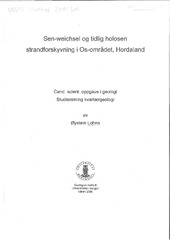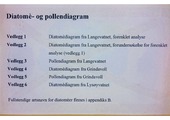| dc.description.abstract | Late Weichselian and Early Holocene relative sea-level changes in four isolation basins in the Os area, Hordaland (Western Norway) were studied using both bio- and lithostratigraphical methods. Isolation and ingression contacts were identified in the cores by means of diatom floral analysis and they were used to construct a relative sea-level curve for the Os area. The chronofogy at the key locality Langevatnet, is established in calendar years by wiggle matching of 9 14C-dates. In the other basins calibrated 14C-dates and correlation of the Betula rise and the Vedde Ash with Langevatnet, were used to obtain calendar year ages. The result is the most precisely dated sea-level curve documenting the Younger Dryas transgression in Western Norway. The sea-level curve from the Os area indicates a relative high sea-level just after the deglaciation followed by a relative sea-level fall to a regression minimum during the B01ling-Allernd. The regression minimum is less than 11,5 meters below the following Younger Dryas transgression maximum defining the m9-fine limit for the area, and limits the amplitude of the Younger Dryas transgression to a maximum 11,5 meter. A !ransgression pattern with two phases of rapid sea-level rise during the Early and Late Younger Dryas, separated by a phase with only a moderate rise, is revealed by the sealevel curve. The transgression maximum was reached in the very Late Younger Dryas, and it lasted in to the Holocene. The major postglacial regression started after the Betula rise, ca. 150 years after the Younger Dryas-Holocene boundary. This sea-level pattern indicates an Early Younger Dryas ice advance, followed by a more stable ice front, until the glacier advanced to its maximum position at the Herdla Moraine in the very Late Younger Dryas. This study indicates an age of 14.800-14.400 cal. yr. B. P. for the deglaciation in the Os area; an age that may be valid also for the coast west of Bergen. This age is compatible with the ice advances suggested during the Older Dryas (about 12.200 14C B. P.), documented by the Ulvøy Till on Blomøy. | en_US |

